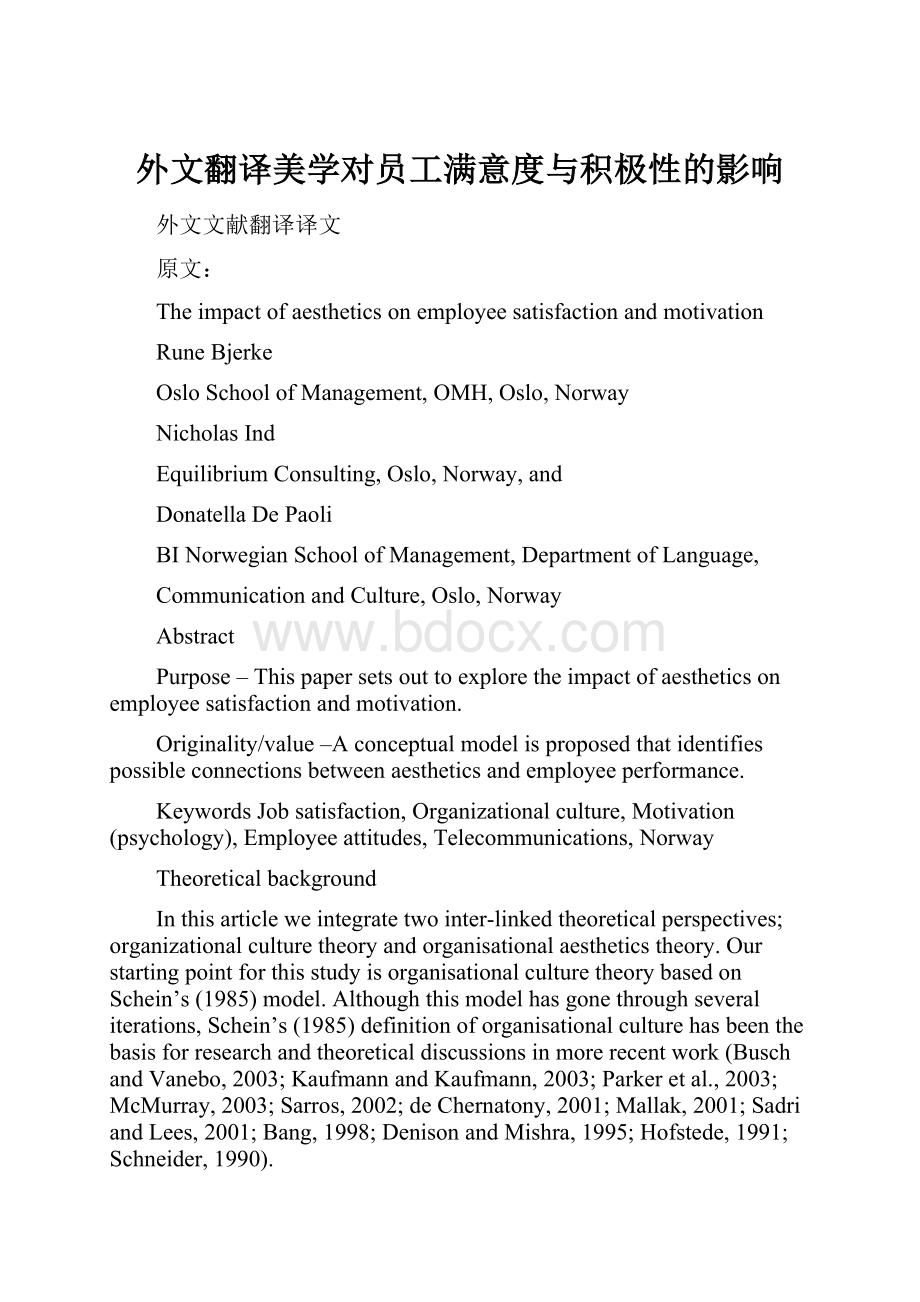外文翻译美学对员工满意度与积极性的影响.docx
《外文翻译美学对员工满意度与积极性的影响.docx》由会员分享,可在线阅读,更多相关《外文翻译美学对员工满意度与积极性的影响.docx(12页珍藏版)》请在冰豆网上搜索。

外文翻译美学对员工满意度与积极性的影响
外文文献翻译译文
原文:
Theimpactofaestheticsonemployeesatisfactionandmotivation
RuneBjerke
OsloSchoolofManagement,OMH,Oslo,Norway
NicholasInd
EquilibriumConsulting,Oslo,Norway,and
DonatellaDePaoli
BINorwegianSchoolofManagement,DepartmentofLanguage,
CommunicationandCulture,Oslo,Norway
Abstract
Purpose–Thispapersetsouttoexploretheimpactofaestheticsonemployeesatisfactionandmotivation.
Originality/value–Aconceptualmodelisproposedthatidentifiespossibleconnectionsbetweenaestheticsandemployeeperformance.
KeywordsJobsatisfaction,Organizationalculture,Motivation(psychology),Employeeattitudes,Telecommunications,Norway
Theoreticalbackground
Inthisarticleweintegratetwointer-linkedtheoreticalperspectives;organizationalculturetheoryandorganisationalaestheticstheory.OurstartingpointforthisstudyisorganisationalculturetheorybasedonSchein’s(1985)model.Althoughthismodelhasgonethroughseveraliterations,Schein’s(1985)definitionoforganisationalculturehasbeenthebasisforresearchandtheoreticaldiscussionsinmorerecentwork(BuschandVanebo,2003;KaufmannandKaufmann,2003;Parkeretal.,2003;McMurray,2003;Sarros,2002;deChernatony,2001;Mallak,2001;SadriandLees,2001;Bang,1998;DenisonandMishra,1995;Hofstede,1991;Schneider,1990).
AsWeber(1930)originallysuggested,cultureisacriticalaspectoftheadaptationofsocialorganisations,andisasystemof“sociallytransmittedbehaviorpatternsthatservetorelatehumancommunitiestotheirecologicalsettings”.ThisviewoncultureissimilartohowHofstede(1980,1991;Hofstedeetal.,1990)andSchein(1985,1990)describesculture.Schein’sthoughtsandworkremainthebasisofaconsiderableamountofsubsequentthinking.InthispaperwedevelopSchein’s(1985)modeltotakeintoaccountourfocusonthevalueofart,designandarchitecture(inhismodel,describedasartifacts)andourdifferenceofperspective:
wenotonlylooksatmanagementintentbutalsothereactionsofemployeestotheenvironment.
ThespecificorganisationwehaveresearchedinthisconceptualandexplorativestudyisTelenor.TelenorisamajorNorwegiantelecommunicationscompany.Thewillingnessofcompaniestoinvestsubstantiallyandconsciouslyinartifacts,meansthisstudycanserveasabasisforunderstandingmoreabouttherelationshipbetweenaesthetics,organisationandmarketing.Thiswillhelporganisationstomakebetterjudgmentsaboutwhenandhowtoinvestinart,architectureanddesignandtomovedecisionmakingaboutaestheticsfromalargelysubjectiveperspectivetoonethatintegrateswithoverallbusinessobjectives.Ourintentionistodevelopaconceptualframework,basedonanassessmentofmanagementgoalsanddatafromin-depthinterviewsofTelenoremployees,toidentifythelikelyimpactofaestheticsonemployeesatisfaction,identity,creativity,mood,andmotivation.
Designandmethodology
Sincetheliteratureseemsnottosuggestspecificallywhetherart,designandarchitecture,astraitsoftheorganisationalculture,caninfluenceemployeesatisfaction,identity,motivationandpossibleotherdimensions(unknownconnections/links)anexplorativedesignwasappliedinthisproject(Creswell,1998;Churchill,1999).AccordingtoWilson(2001)agoodcomprehensionoftheorganisationcultureisimportantinordertoanalyseit.Further,theanalysismustbecomplexinnatureWilson(2001)andcontainallelementsoftheorganisationalculture(Parkeretal.,2003;deChernatony,2001;Schein,1985).
AccordingtoCreswell(1998)qualitativemethodsshouldbeappliedwhenidentifyingmotivesandattitudesamongemployees.McDanielandGates(1999)maintainthatqualitativemethodsareofparticularusefulwhentheoverallresearchobjectivesareinterpretationandunderstandingofmeanings.Schein(1990)underscorestheimportanceofusingaqualitativeapproachtogatherperceptionsaboutorganisationalculturesamongmembersoforganisations.Withsuchanapproach,itispossibletounderstandhowcultureshaveevolvedovertime.Findingscanbelabeled,organisedanddiscussedaccordingtotheterminologyoforganizationalcultureandaesthetics.
Sample
Thebehaviorofemployeesindirectcontactwithcustomersonadailybasisisimportantconcerningthecommunicationoftheorganisationalvalues,brandvaluesandobjectives(Wilson,2001;Ind,2003;deChernatony,2001).Adoptedvalues,norms,andassumptionsderivedfromtheorganisationalculturemayinfluenceactions(behaviour)andwaysofcommunicating.Normann(1991)pointsoutthatemployees’dealingdirectlywithcustomersaretheoutwardfaceoftheorganisation.TounderstandthelinkagebetweentheinternalandexternalweonlyinterviewedTelenoremployees,whowereincontactwithcustomersonadailybasis.TherespondentsworkedinTelenorMobil,TelenorNetworksandTelenorCustomerService.Theintervieweeswereselectedbecausetheywereassumedtohaveknowledgeandunderstandingoftheirownworkingenvironmentandhaveopinionsaboutit(Berg,2001;Churchill,1999).
Datacollection:
in-depthinterviews
Sixexpertinterviewswerecompleted.Theexpertshadin-depthknowledgeaboutartandbusiness,workenvironment,organisationalculture,brandbuildingand
aesthetics,andaboutTelenor’sinvestmentsinart,designandarchitecture.Atotalof24in-depthinterviewsofTelenoremployees(dealingwithcustomers)werecompletedin2003atTelenor.ThepurposewastohavetherespondentsdescribehowtheyperceivetheorganisationalcultureatTelenor,inrelationtotheart,design,andarchitecturethatrepresentstheirworkingenvironment.Asanintroductiontotheinterviews,therespondentswereaskedquestionsaboutTelenor’svisionandvalues.
Findingsanddiscussion
Therespondents’viewontheart,design,andarchitectureatTelenorisvaried.Ingeneral,themajoritythinkthattheartisniceandexciting.Manyoftherespondentsseemtolikethecompositionoftheart,thedesignandthearchitecture,andthetotalexperienceofhowthethreeelementsareintegrated.Severalemployeesbelievethatart,designandarchitecturemayhaveanunconsciousinfluentialeffect,althoughgenerallytheydonotreflectonthepossibleimpactintheirday-to-dayworkinglives.Someoftherespondentshadacriticalattitudetowardssomespecificphysicalelementslikeopenofficespace,thecolumnsinthespacebetweentwolargebuildings(asculpturalfeature),andthemoving,red,electronictextmovingalongalargenarrowscreenonthetopofoneofthebuildings(onthefacade)(bytheAmericanconceptualartistJennyHolzer).ThisvariedanddissimilarviewonthephysicalenvironmentandartifactsamongindividualsisalsopointedoutasaculturalcharacteristicbyBordieu(1984).
Somerespondentsclaimednottounderstandpartsoftheartdisplayedinthebuildingsandthatsomeofthedesignwasuncomfortable(mostlymodernclassicdesignsderivedfromtheBauhausaestheticormodernScandinaviandesigners,suchasArneJacobsen).Somerespondentsmentionedthattheystoppedbeingconsciousoftheartandcametoseeitasanatural,unconsciousexperience.Thus,theyreferredtotheirviewontheart,designandarchitectureasatotalexperiencewithoutbeingabletoseparatespecificelements
Motivation
Mostoftherespondentsclaimedtobemotivatedattheirwork.Severalmentionedthatthequalityoftheirworkingcolleagueswasakeyfactor.Manyofthoseworkingwithinthebusiness-to-businesssegmentstatedthattheyweremotivatedbytheirspecifictasksandthepositiontheyheldaswellastheresponsibilitytheyhaveandtheflexibilitytheyenjoy.ThislinkstoHerzberg’sthinking,derivedfromhisstudieswithMausnerandSnydermanthatpeoplearesatisfiedbytheintrinsicsoftheirworkandthatperformanceleadstosatisfactionandnottheotherwayround(Herzbergetal.,2003).SeveraloftheTelenorpeoplewhoworkdirectlywithconsumerspointedoutthatthereisnotmuchroomforflexibility,freedomandresponsibilityintheirjobs.Thisfindingmayindicatethatthoseworkingwiththebusinesssegmentaremoremotivatedthanthoseworkingwiththeconsumersegmentbecausetheyhavegreaterpotentialtoperformandachievefulfillment.Somerespondentsmentionedartordesignorarchitectureaspossiblemotivationalfactors,buttherewerenoclearstatementsfromtherespondentsthatanyoftheseseparateelementshadadirectimpact.However,itwassuggestedthattheexperienceofthetotalityofthosethreeelementsofthephysicalenvironmentcouldhaveanimpactonmotivation.Thereasongivenwasthatanicephysicalenvironmentcouldhaveanimpactonemployees’mood,wellbeing,aninspiration,whichinturninfluencesmotivation.Afewrespondents,whowerenotsointerestedintheenvironment,didnotbelievethatanyoftheelementsofart,designorarchitecturehadaninfluenceonmotivation.
Employeesatisfaction
Itseemedhardfortherespondentstodistinguishbetweenmotivationandsatisfaction,whichcouldindicatethatemployeesperceivethesetwoideastoberelated.Pleasantworkingenvironment,nicecolleagues,andvariedjobtaskswerementionedbothasmotivational–andsatisfactionfactors.
Theanalysisoftheinterviewsrevealedthatemployeesatisfactionseemedgood.Astothepossibleimpactofthephysicalenvironmentonsatisfaction,therespondentssaidthattherecouldbesucharelation,buttheydidn’tthinkthatpeopleweresoawareoftheinfluentialpowerofart,designandarchitecture.Ingeneral,respondentsbelievedthataniceenvironmentcreatedpositivefeelings.Andseveralrespondentsagreedthatiftheuniqueart,design